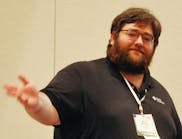How control network stakeholders build a collaborative team
While the digital engineering team owns and maintains the process control system at Duke Energy, the team also extends network access beyond read-only to others in the organization, especially during system projects and upgrades. At the 2025 Honeywell User Group conference, Mark Whitman, digital systems engineer at Duke Energy, discussed why expanding network access outside his team and ensuring open communication is essential to effective upgrades.
“If you try to do it all on your own, it’s going to be a headache,” Whitman said.
With several ongoing infrastructure projects, Duke Energy is replacing all legacy network equipment within the next three to four years. “We have a heavy design influence into what’s going into our network,” Whitman said. “You need multiple people from the organization to help you.”
This means get to know the key stakeholders who own the project while it’s being developed, both in management and design. As a network owner, if you spend time with people involved with these upgrade projects and develop open communication with those implementing new designs, digital system owners can influence decisions that will improve network operations in the long run.
“You have to know how your company is funded. To get projects funded, know what’s important to your management,” Whitman said. “What’s important for me on a day-to-day basis is that I think about a 10-year plan for my system.”
Get involved early on
The company has an involved process for long-term asset management. “When we want to replace the system, we have to put in a request as early as possible,” Whitman said. “When you establish your long-term goals, you talk to your design organization. You get their manager aligned, so that they’ll accept the project when it gets to them.” It also helps to tailor requests to meet other long-term goals for the organization.
After the Duke Energy upgrade project began in 2018, the company started increasing access to the system across the organization. “We got more and more people familiar with the system,” Whitman said. “This is more Windows administration level, allowing people to have administrative access to a system, where before it was a silo and you were a single point of contact. Everything being put on the system goes through you, which is very highly stressful and not recommended.”
Whitman said inter-departmental communication requires a bit of “social engineering.” If other coworkers are simply a little dot on the Teams’ screen, and you’ve never met them in person, when you go to ask them for help you have a much less likely chance of them helping you or making your needs a priority. “Oftentimes, I’ll go to a person, instead of sending them a Teams’ message because it’s more personal and it’s harder to say ‘no’ when I need help. Plus, it helps for when you do have to use those other means of communication to get help.”
Once a project gets funded, that’s when communication with the management group comes into play. “This is the hard part. Our managers are always in meetings, so trying to find time to talk to them in person has been the hardest part,” Whitman said.
As an example, Whitman had to fight to implement scripts for cybersecurity maintenance measures. Two or three manual measures, which typically took two days, were turned into a script that pulls all the information in, compares it to what the documentation says, and the process instead takes 30-40 minutes. “Having to fight your own management to align on the priorities is another piece of this,” Whitman said.
Celebrate the wins
Another important part of the communication puzzle is celebrating the wins, even small ones. “When a project is completed, talk to the people that were involved with it. Congratulate them. Be happy with them, because for anything in nuclear to finish and get the turnover, it’s a monumental task to get there.”
Whitman said he has counterparts that don’t go to factory acceptance tests and don’t want to be involved in that process. “That’s the absolute wrong way to approach a system that you’re going to be in charge of for years to come. You have to be part of building things from scratch to actually understand them,” Whitman said. “If you don’t force yourself to be involved in the early stages, you miss all your opportunities. Even when they’re building the budget, they need to budget for you going to the factory acceptance test.”
As the digital group at Duke Energy, those engineers also interface with and touch the plant’s system itself. “That’s unusual for nuclear. You usually have engineers that sit back and watch a maintenance tech or an operations tech touch the plant. We have keyboard time on the live system regularly,” Whitman said.
“Help other organizations with your expertise. Be a mentor. Teach them your network,” Whitman said. “Enable them to learn your system. Enable them to be on your system. Start off with basic user access and build them up. It takes time.”
Whitman recommends that network owners have to trust people, yet establish rules. “Anybody that I’ve ever let on my system, I will tell them the first day that I’ve given you a certain level of rights on the system: If you break the system and cannot fix it, you lose access, and it will take your manager’s manager to get you back on. That’s my boiling point,” Whitman said. He has also never had to disable anyone’s account.
Building an organization that understands the network benefits the whole company. “When things break, you don’t want to be the only one that can fix it,” Whitman said.
